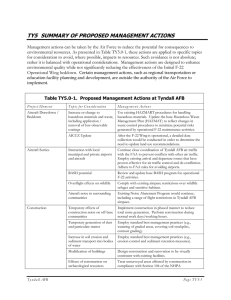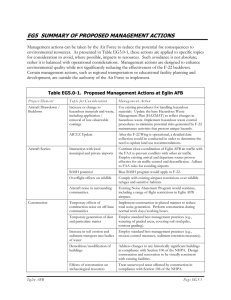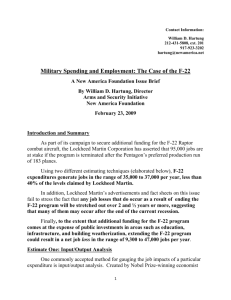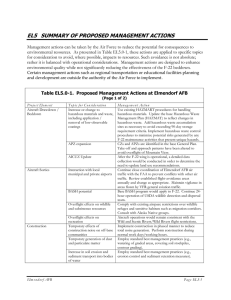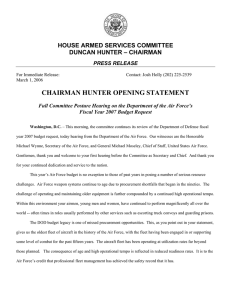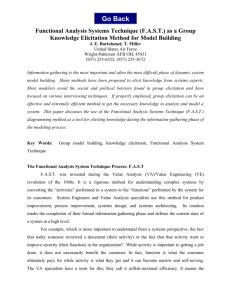GAO F-22 AIRCRAFT Progress in Achieving Engineering and
advertisement
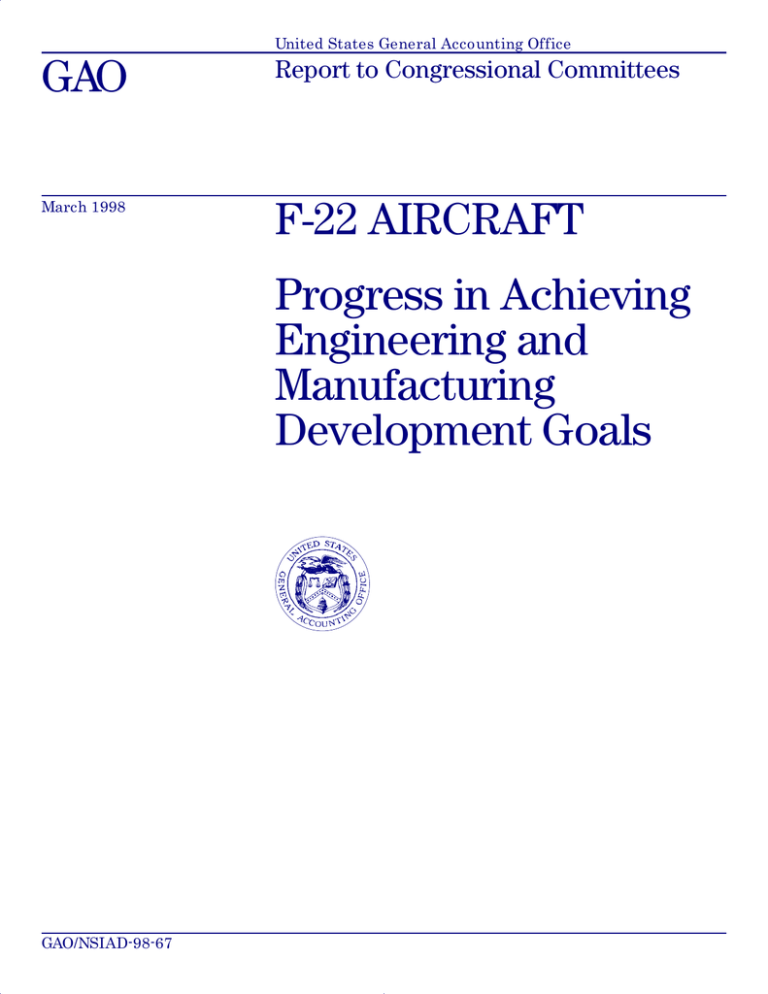
United States General Accounting Office GAO Report to Congressional Committees March 1998 F-22 AIRCRAFT Progress in Achieving Engineering and Manufacturing Development Goals GAO/NSIAD-98-67 GAO United States General Accounting Office Washington, D.C. 20548 National Security and International Affairs Division B-278307 March 10, 1998 Congressional Committees As required by the National Defense Authorization Act for Fiscal Year 1998 (P. L. 105-85), we reviewed the Air Force’s F-22 engineering and manufacturing development (EMD) program. This report presents our conclusions regarding whether the EMD program is likely to be completed at a total cost that does not exceed the cost limitation established in the act. The report also discusses the extent to which the cost, schedule, and performance goals for the F-22 EMD program are being met and identifies contract modifications expected to have a significant effect on cost or performance of F-22 aircraft. The act requires us to certify whether we had access to sufficient information to make judgments on the matters covered by this report. Background The F-22 is an air superiority aircraft with the capability to deliver air-to-ground weapons. The most significant advanced technology features include supercruise, the ability to fly efficiently at supersonic speeds without using fuel-consuming afterburners; low observability to adversary systems; and integrated avionics to significantly improve the pilot’s situational awareness. The objectives of the F-22 EMD program, begun in 1991, are to (1) design, fabricate, test, and deliver 9 F-22 flight test vehicles, 2 ground test articles, and 26 flight qualified engines; (2) design, fabricate, integrate, and test the avionics suite; and (3) design, develop, and test the F-22 system support and training systems. In June 1996, because of indications of potential cost growth on the F-22 program, the Assistant Secretary of the Air Force for Acquisition chartered a Joint Estimating Team (JET) consisting of personnel from the Air Force, the Department of Defense (DOD), and private industry. The objectives of the JET were to estimate the most probable cost of the F-22 program and to identify realistic initiatives that could be implemented to lower program costs. In January 1997, the JET estimated the F-22 EMD program would cost $18.688 billion, an increase of about $1.45 billion1 over the previous Air Force estimate. The JET also reported that additional time would be 1 JET estimated the increase at $2.16 billion; however, a decision to delete preproduction aircraft, estimated to cost $0.71 billion, reduced the estimated increase to $1.45 billion. Page 1 GAO/NSIAD-98-67 F-22 Development Program B-278307 required to complete the EMD program and recommended changes to the EMD schedule. The Air Force and Under Secretary of Defense for Acquisition and Technology adopted the JET’s recommendations, including its cost estimate for the EMD program. Other JET recommendations included slowing the manufacturing of the EMD aircraft to ensure an efficient transition from development to low-rate initial production and increasing the time available to develop and integrate avionics software.2 In August and September 1997, the Air Force negotiated changes with the prime contractors3 to more closely align the cost-plus-award-fee contracts with the JET cost estimate and revised schedule. However, as of January 1998, many substantial planned changes recommended by the JET had not been incorporated into the Lockheed Martin contract, such as changes to the avionics estimated to cost $221 million. The National Defense Authorization Act for Fiscal Year 1998, enacted on November 18, 1997, imposed cost limitations of $18.688 billion on the F-22 EMD program and $43.4 billion on the production program. The limitation on production cost did not specify a quantity of aircraft to be procured. The act instructed the Secretary of the Air Force to adjust the cost limitations for (1) the amounts of increases or decreases in costs attributable to economic inflation after September 30, 1997, and (2) the amounts of increases or decreases in costs attributable to compliance with changes in federal, state, or local laws enacted after September 30, 1997. Conferees for the Department of Defense Appropriations Act, 1998, enacted October 8, 1997, provided direction to the Secretary of the Air Force regarding out-of-production parts on the F-22 program. Because it is not economical for some component manufacturers to keep production lines open to produce old technology parts with low demand, they have discontinued making parts, some of which are used on the F-22 EMD aircraft, and will discontinue making others. To minimize cost and schedule impacts on the F-22 EMD and production programs, the Air Force plans to redesign these out-of-production parts or buy sufficient quantities of them for the first five lots of production aircraft. The appropriations conferees directed the Secretary of the Air Force to fund the cost of redesigning out-of-production parts from the Research, Development, Test 2 For more information on the JET’s recommendations see Tactical Aircraft: Restructuring of the Air Force F-22 Fighter Program (GAO/NSIAD-97-156, June 4, 1997). 3 The major prime contractors are Lockheed Martin Aeronautical Systems for the aircraft and United Technologies Corporation (Pratt & Whitney) for the engines. Page 2 GAO/NSIAD-98-67 F-22 Development Program B-278307 and Evaluation appropriation. The effect of following that direction would be to add that effort, expected by the Air Force to cost $353 million, to the EMD program. In January 1998, the Air Force notified the Congress that it increased the EMD cost limitation by $353 million, to respond to direction from the conferees, and decreased the production cost limitation by the same amount. As adjusted, the EMD cost limitation increased to $19.041 billion. In addition, the Air Force plans to adjust the cost limitation downward by $102 million to $18.939 billion, to recognize revisions to inflation assumptions by the Office of the Secretary of Defense. Results in Brief The Air Force’s estimate to complete F-22 EMD is $18.884 billion, $55 million less than the EMD cost limitation that will be adjusted to $18.939 billion. However, the F-22 EMD program is not meeting schedule goals established in response to the JET review. The first flight of the F-22 was about 3 months late, issues have emerged concerning production and delivery of wings and fuselages for the EMD aircraft, and test schedules have consequently been delayed. Lockheed Martin has indicated that negotiated costs should not be exceeded because of these issues. The Air Force, however, is further assessing the impact of these issues on EMD cost, the schedule upon which test data is produced, and the schedule upon which the EMD program is to be completed. The Air Force expects to complete this assessment at the end of February 1998. The Air Force is estimating that the F-22 will meet or exceed its performance goals. However, less flight test data have been accumulated through January 1998 than were expected because the beginning of the flight test program was delayed from May 1997 to September 1997 and flight tests have been suspended to accomplish planned ground tests and minor structural additions to the airframe. Flight testing will not resume until April 1998. Delayed tests reduce the amount of actual F-22 performance information that will be available to support Air Force plans to begin production in fiscal year 1999. The Air Force and contractors provided us access to sufficient information to make informed judgments on the matters covered by this report. This is discussed further in appendix II. Page 3 GAO/NSIAD-98-67 F-22 Development Program B-278307 In the fiscal year 1999 President’s budget, the Air Force’s estimate to complete the EMD program was $18.884 billion. The estimated cost to complete EMD includes the negotiated prices of the major prime contracts, estimated costs of significant planned contract modifications, other government costs, and a margin to accommodate future cost growth. Extent to Which the F-22 Program Is Meeting the Cost Goal for the EMD Program Although contractor reports through December 1997 project that the efforts on contract are expected to be completed within the negotiated contract prices, manufacturing problems with the wings and the aft fuselage could change those projections for Lockheed Martin. Estimated Cost of EMD The Air Force contracts with Lockheed Martin and Pratt & Whitney, after being restructured, had negotiated prices of $16.003 billion. The Air Force, as of December 1997, planned to add modifications to the contracts totaling about $1.546 billion. The Air Force’s estimated costs for F-22 EMD are shown in table 1. Table 1: Air Force Estimated Cost of F-22 EMD Dollars in billions Element of cost Amount Lockheed Martin and Pratt & Whitney contracts $16.003 Planned modifications to contracts 1.546 Other government costs 1.184 Margin for cost growth 0.151 Total costs Modifications Planned to EMD Contracts $18.884 Air Force officials provided us a list of planned and budgeted modifications that will increase the contract prices. The list is consistent with the JET findings. Modifications planned relate to • • • • efforts directed by the conferees on the Department of Defense Appropriations Act, 1998, to redesign out-of-production parts ($353 million); award fees to be paid to the contractor based on evaluations of contractor performance ($262 million); extending the time period for F-22 testing ($230 million); addition of changes (Block IV) to the avionics, including interface capability with the newly developed AIM-9X air-to-air missile ($221 million); Page 4 GAO/NSIAD-98-67 F-22 Development Program B-278307 • • • • • • Limited Cost Experience Indicates Contract Cost Goals Are Being Met extending the time period for keeping an active laboratory infrastructure ($158 million); efforts to provide the capability to perform air combat simulation and ground testing of avionics prior to its delivery ($65 million); provision for contractor resources to conduct initial operational test and evaluation ($60 million); efforts to test and approve the F-22 for supersonic launch of external missiles ($51 million); implementation of aircraft battle damage repair capability ($29 million); and other changes ($117 million). Since the contracts were restructured in August and September 1997, limited experience has been accumulated to indicate the extent to which contractors are completing scheduled work at the planned cost. Contractor reports reflecting experience through December 1997, however, indicate the contractors are predicting they will be able to complete efforts now covered by the contract within the negotiated costs. Lockheed Martin and Pratt & Whitney report to the Air Force monthly concerning their progress compared to contract costs and schedules. These reports define the cost and schedule variances from the contract plans. When the contracts were restructured, the contractors rebaselined their cost control systems that measure the cost and schedule progress and calculate how the actual costs and schedules vary from the goals. Prior to restructuring the contracts, the Lockheed Martin and Pratt & Whitney reports indicated unfavorable variances at completion of EMD totaling about $1.2 billion. Both Pratt & Whitney and Lockheed Martin reports showed variances of less than 1 percent from the negotiated contract cost and planned schedule through December 1997. The most significant variance identified in the contractor reports was about a $54 million unfavorable schedule variance for Lockheed Martin. The contractors’ reports showed that the negotiated costs include about $194 million for management reserves. Management reserves are amounts set aside to react to cost increases due to unplanned efforts or cost growth in planned efforts. Lockheed Martin and Pratt & Whitney December 1997 reports indicate they plan to complete the contract efforts within the negotiated costs. However, the impact of delays in the delivery of wing and aft fuselage assemblies and the flight test program have not been reflected in those reports. Lockheed Page 5 GAO/NSIAD-98-67 F-22 Development Program B-278307 Martin has advised the Air Force that it can execute the revised schedule caused by the late deliveries at no increased cost to the EMD contract. At the time of our review, the Air Force was assessing the impact of these delays and whether it agrees that the changes can be accomplished with no cost increase to the EMD contract. Extent to Which the F-22 Program Is Meeting the Schedule Goals for the EMD Program In January 1998, the F-22 program was not meeting its schedule goals. The first flight of an F-22 did not occur on time and resumption of its flight test program will be delayed by at least 2 to 3 weeks to correct a problem discovered in the horizontal tail of the aircraft. Also, the late delivery of aft fuselage assemblies and wing assemblies is expected to cause delays in delivery of other EMD aircraft. These problems will also delay the progress of the flight test program. The Air Force has revised its schedule to reflect the late first flight. However, it had not determined how the late deliveries of aft fuselage assemblies and wing assemblies will impact the overall F-22 EMD schedule. The Air Force planned to complete its evaluation of the impact on the schedule by the end of February 1998. First F-22 Flight Over 3 Months Late Because of a number of technical problems with the aircraft, the first flight of the first F-22 EMD aircraft was delayed over 3 months, until September 7, 1997. According to the Air Force, the problems were not caused by the design of the aircraft but involved a fuel tank leak, failure of an auxiliary power unit resulting from faulty installation, a software defect, incorrect installation of the electrical connector to a fuel tank probe, and foreign object damage from debris being ingested into an engine. After making two flights, the aircraft flight test program was suspended to accomplish planned ground tests and minor structural additions to the airframe. Resumption of the flight test program, planned for March 1998, is expected to be delayed until at least April 17, 1998, because materials in the horizontal tail of the aircraft became disbonded, or separated. Air Force officials said a solution to this problem has been identified and it will not impact other EMD aircraft schedules. Impact of Late Aircraft Deliveries on Test Plans for Fiscal Years 1998 and 1999 The flight test schedule was updated in May 1997 based on the review of the program by the JET, with first flight planned to occur in late May 1997. However, because first flight did not occur as scheduled, the beginning of the flight test program was delayed. Flight tests are also expected to be delayed because of problems with manufacturing wings and aft fuselages Page 6 GAO/NSIAD-98-67 F-22 Development Program B-278307 and expected late delivery of the third through sixth EMD flight test aircraft. Because of the delay in first flight and expected delays in delivery of several later EMD aircraft, a number of flight test hours planned for fiscal years 1998 and 1999 have been deferred until later in the test program. About 55 percent (120 of 217 hours) of the flight test hours planned for fiscal year 1998 and about 11 percent (51 of 449 hours) of the flight test hours planned for fiscal year 1999 have been deferred until later in the test program. Although test hours planned for the early stages of the flight test program are now planned to be accumulated more slowly, Air Force officials said the total number of flight test hours planned, the number of flight test months planned, and the completion date for the F-22 EMD program remain about the same. Wings and Aft Fuselages Are Expected to Be Late for Most EMD Aircraft Wing deliveries are behind schedule because of problems with the development and manufacturing of large titanium wing castings, the foundation upon which the wing is built. As of January 1998, the contractor and the Air Force were still working to resolve the casting problem. The wings for the next four flight test aircraft and the two ground test articles are expected to be delivered about 2 weeks to over 4 months late to Lockheed Martin. Delivery of the F-22 aft fuselage—the rear aircraft body section—is expected to be late for the next four flight test aircraft and the two ground test articles because of late parts deliveries and difficulties with the welding process caused by tight tolerances when fitting the many pieces of the fuselage together. An Air Force and contractor team has been formed to evaluate potential cost, schedule, testing, and production impacts associated with this problem. This team plans to complete its assessment by the end of February 1998. As a result of the late deliveries of the wings and aft fuselages, the first flights of the third through the sixth EMD aircraft are expected to be from about 2 weeks to over 5 months late. Air Force officials said first flight of the second EMD aircraft is expected to occur on schedule because the time available between production of the first and second EMD aircraft is expected to be sufficient to allow the manufacturing problems to be corrected. Since there was significantly less time scheduled between the second EMD aircraft and subsequent EMD aircraft, first flight of later EMD Page 7 GAO/NSIAD-98-67 F-22 Development Program B-278307 aircraft will be delayed. Table 2 compares the May 1997 scheduled first flights to the expected dates of first flights as of January 1998. Table 2: Comparison of Schedules for First Flights of EMD Aircraft EMD aircraft Scheduled first flight as of May 1997 Expected first flight as of January 1998 Months of delay in first flight 4001 May 29, 1997 September 7, 1997a 3.3 4002 July 9, 1998 July 9, 1998 4003 June 16, 1999 November 22, 1999 5.2 4004 August 17, 1999 February 3, 2000 5.6 4005 January 11, 2000 March 31, 2000 2.7 4006 May 18, 2000 May 30, 2000 0.4 4007 September 25, 2000 September 25, 2000 0 4008 February 2, 2001 February 2, 2001 0 4009 June 1, 2001 June 1, 2001 0 0 a Actual date of first flight. Extent to Which the F-22 Program Is Meeting the Performance Goals for the EMD Program The Air Force estimates that the F-22 will meet or exceed the goals for the major performance parameters. These include 10 parameters4 for which the Air Force reports regularly to DOD, and two additional performance features GAO reviewed that relate to other critical characteristics of the F-22 aircraft. The Air Force estimates how performance is expected to compare to specific goals for each parameter by estimating and summarizing the performance of relevant subparameters. The estimates are engineering judgments based on computer and other models, tests of some components in flying test beds, ground tests, analyses, and, to a limited extent, flight tests. The goal for each parameter is based on the EMD contract specifications. Goals for the many subparameters (about 160) are established to ensure that the goal for each parameter can be met. Although the Air Force has not included them in the 10 parameters for regular reporting, we identified and reviewed two additional features—situational awareness and low observability—that are an integral part of the F-22 being able to operate as intended.5 The F-22 4 The 10 parameters are radar cross section from the front sector of the aircraft, supercruise, acceleration, maneuverability, payload, combat radius, radar detection range, airlift support, sortie generation rate, and mean time between maintenance. 5 Although these additional features are not official performance parameters, the Air Force does consider them critical system characteristics, which it describes as generic characteristics that do not lend themselves as well to measurement and reporting. Page 8 GAO/NSIAD-98-67 F-22 Development Program B-278307 sensors, advanced aircraft electronics, and cockpit display screens are required to provide the pilot improved situational awareness of potential enemy threats and targets. This increased awareness is to improve pilot response time to the threats, thus increasing the lethality and survivability of the aircraft. The aircraft’s low observable or “stealthy” features allow it to evade detection by enemy aircraft and surface-to-air missiles. We believe the situational awareness and low observability features are critical to the success of the F-22 program and, therefore, we reviewed them and are reporting on the Air Force’s progress in achieving them along with the 10 parameters the Air Force established. The Air Force’s 10 parameters and the 2 additional features we identified and reviewed are described in appendix I. Air Force Estimates of F-22 Performance As of January 1998, the Air Force estimated that, at the end of the EMD program, the F-22’s performance will meet or exceed the goals for all 10 established parameters. Table 3 shows the goal (contract specification) for each parameter; the estimated performance achieved for each parameter based on computer models, analyses, or testing; and the Air Force’s current estimate of the performance each parameter is expected to achieve by the end of EMD. Most of the goals and related performance information are classified and are therefore shown as percentages instead of actual numbers. To interpret the table, it is constructed so that estimated performance greater than the goal is better than the goal, except for airlift support where using fewer assets is better. Table 3 also shows the two additional features that we included (situational awareness and aircraft low observability) because of their importance to the success of the F-22 program. Page 9 GAO/NSIAD-98-67 F-22 Development Program B-278307 Table 3: Estimates of Performance for Selected Parameters and Additional GAO Identified Features Key performance parameters Goal (contract specification) Estimated performance achieved to date Air Force current estimate at EMD completion Supercruise 100% 114% 114% Acceleration 100% 108% 107% Maneuverability 100% 100% 100% Airlift support (C-141 equivalents) 8 7 to 9 Less than 8 Sortie generation rate 100% 104% 103% Radar cross section, front sector only 100% Favorable Favorable Mean time between maintenance 3.0 hours 3.1 hours 3.1 hours Payload (missiles) 6 medium-range 2 short-range 6 medium-range 2 short-range 6 medium-range 2 short-range Combat radius 100% 127% 127% Radar detection range 100% 117% 117% Additional features reviewed by GAO Goala Estimated performance achieved to date Current estimate at EMD completion Situational awareness 100% Favorable Favorable Low observability 100% Favorable Favorable a These goals are not contract specifications. We assigned a value of 100% to evaluate the features. Basis for Air Force Estimates We evaluated the basis for the Air Force’s current performance estimates by reviewing and analyzing performance information and estimates for subparameters that are the components of each parameter. We reviewed selected analyses, test reports, and plans the Air Force used to formulate its estimated performance achieved to date and projected estimates for the end of EMD. As of January 1998, estimated performance concerning two subparameters, aircraft weight and fuel usage, was not expected to achieve goals established for those subparameters. However, the Air Force’s analysis indicates that failure to achieve those goals will not cause the associated parameters to fail to meet their established goals. For example, aircraft empty weight is a subparameter that affects the supercruise, acceleration, maneuverability, and combat radius performance parameters. Although the aircraft’s empty weight is currently Page 10 GAO/NSIAD-98-67 F-22 Development Program B-278307 expected to be 2 percent higher than the established goal for that subparameter, Air Force analyses indicate that the increased weight is not significant enough to cause the estimates for the affected parameters to not meet their goals. A more extensive discussion of our analysis and a chart listing the major performance subparameters are included in appendix II. Conclusion The Air Force’s estimate to complete F-22 EMD is $18.884 billion, $55 million less than the EMD cost limitation that will be adjusted to $18.939 billion. However, issues have emerged concerning production and delivery of wings and fuselages for the EMD aircraft, and test schedules have consequently been delayed. The Air Force is further assessing the impact of these issues on EMD cost, the schedule upon which test data is produced, and the schedule upon which the EMD program is to be completed. The Air Force is estimating that the F-22 will meet or exceed its performance goals. However, less flight test data have been accumulated through January 1998 than were expected because the flight test program was delayed and flight tests have been suspended to accomplish planned ground tests and minor structural additions to the test aircraft airframe. Delayed tests reduce the amount of actual F-22 performance information that will be available to support Air Force plans to begin production in fiscal year 1999. Agency Comments In commenting on a draft of this report, DOD generally concurred with it and advised us the Air Force has notified the Congress about changing the EMD and production cost limitations to recognize direction from the conferees on the fiscal year 1998 Defense Appropriations Act. As a result of this additional information, we have removed a matter for congressional consideration that had been included in the draft report. DOD’s comments are included in appendix III to this report. We performed our review between July 1997 and February 1998 in accordance with generally accepted government auditing standards. A description of our objectives, scope, and methodology is included in appendix II. Page 11 GAO/NSIAD-98-67 F-22 Development Program B-278307 We are sending copies of this report to the Secretaries of Defense and the Air Force; the Director, Office of Management and Budget; and other interested parties. Please contact me at (202) 512-4841 if you or your staff have any questions concerning this report. Major contributors to this report are listed in appendix IV. Louis J. Rodrigues Director, Defense Acquisitions Issues Page 12 GAO/NSIAD-98-67 F-22 Development Program B-278307 List of Congressional Committees The Honorable Strom Thurmond Chairman The Honorable Carl Levin Ranking Minority Member Committee on Armed Services United States Senate The Honorable Ted Stevens Chairman The Honorable Daniel K. Inouye Ranking Minority Member Subcommittee on Defense Committee on Appropriations United States Senate The Honorable Floyd Spence Chairman The Honorable Ike Skelton Ranking Minority Member Committee on National Security House of Representatives The Honorable C. W. Bill Young Chairman The Honorable John P. Murtha Ranking Minority Member Subcommittee on National Security Committee on Appropriations House of Representatives Page 13 GAO/NSIAD-98-67 F-22 Development Program Contents Letter 1 Appendix I Description of F-22 Performance Parameters 16 Appendix II Objectives, Scope, and Methodology 21 Appendix III Comments From the Department of Defense 25 Appendix IV Major Contributors to This Report 28 Related GAO Products 32 Tables Table 1: Air Force Estimated Cost of F-22 EMD Table 2: Comparison of Schedules for First Flights of EMD Aircraft Table 3: Estimates of Performance for Selected Parameters and Additional GAO Identified Features Table II.1: List of F-22 Performance Parameters and Critical Subparameters 4 8 10 23 Abbreviations DOD EMD JET RCS Page 14 Department of Defense engineering and manufacturing development Joint Estimating Team radar cross section GAO/NSIAD-98-67 F-22 Development Program Page 15 GAO/NSIAD-98-67 F-22 Development Program Appendix I Description of F-22 Performance Parameters Supercruise Supercruise means the aircraft can sustain supersonic or mach1 speed without using its afterburners. Supercruise saves fuel and helps reduce the aircraft’s infrared signature by not using afterburners that produce a high infrared signature. A reduced infrared signature, in turn, helps make the F-22 low observable and harder for enemy aircraft and missiles to detect. The measurement used for supercruise is the highest mach obtainable in a stable, level flight at 40,000 feet altitude. The Air Force estimated the F-22 will exceed the supercruise goal by about 14 percent. This estimate was determined by analysis of computer models using the latest data available on aspects such as the engines’ thrust and fuel flow characteristics. Propulsion flight testing is scheduled to begin in the first quarter of 1998 and end in the second quarter of 2000. Acceleration Acceleration is a key parameter because the F-22 must be able to outrun enemy aircraft and exit an area after it employs air-to-air or air-to-ground munitions. The acceleration parameter refers to the amount of time it takes the aircraft to go from 0.8 mach to 1.5 mach at 30,000 feet altitude. The Air Force estimated that the F-22 will be faster than the acceleration goal. This estimate was determined by analysis of computer models and ground test data using the latest data available on the major subparameters affecting acceleration. Propulsion flight testing is scheduled to begin in the first quarter of 1998 and end in the second quarter of 2000 and flight performance testing is scheduled to begin in the fourth quarter of 1998 and end in the third quarter of 2001. Maneuverability The maneuverability parameter is a measurement of the maximum force the aircraft can generate during a turn at 0.9 mach at 30,000 feet altitude without losing speed or altitude. Many additional measures that relate to the maneuverability of an aircraft exist, but the Air Force has determined that this measurement is the most appropriate to demonstrate the general F-22 maneuverability at key flight conditions. The Air Force estimated the F-22 will meet its maneuverability goal. The Air Force estimate was determined by analysis of computer models using the latest data available on the major subparameters affecting maneuverability. Flight performance testing is scheduled to begin in the fourth quarter of 1998 and end in the third quarter of 2001. 1 The ratio of the speed of the aircraft to the speed of sound, which is about 738 miles per hour. Page 16 GAO/NSIAD-98-67 F-22 Development Program Appendix I Description of F-22 Performance Parameters Airlift Support This parameter measures the number of C-141B transport aircraft equivalents required to deploy and maintain a squadron of 24 F-22 aircraft for 30 days without resupply. The goal is to be able to provide this support with eight C-141 equivalents, thereby reducing the assets needed to deploy and the cost of deployment. The Air Force estimated it will require less than eight C-141 equivalents to transport a squadron of 24 F-22s. This estimate was based on a recent study. A mobility demonstration to verify the estimate, which cannot be done until a full squadron of 24 F-22 aircraft is activated, is scheduled for 2004 upon delivery of the 24th production aircraft. A squadron of 24 F-15s requires 19 C-141 equivalents. Sortie Generation Rate Sortie generation rate is defined as the average number of sorties or missions flown per aircraft per day for the first 6 days of a potential conflict. This parameter measures the degree to which the F-22 will be available during the first few days of a potential conflict to achieve and maintain air superiority. The Air Force estimated the F-22 will exceed the sortie generation rate goal. This estimate was based on the results of a 6-day surge analysis done on a computer model using many statistics such as maintenance characteristics, support equipment and resource availability, and aircraft maintenance policy. F-22 maintainability demonstrations are scheduled to be accomplished by 2002 to verify the sortie generation rate estimates. Radar Cross Section The radar cross section (RCS) parameter essentially refers to how large the F-22 should appear to enemy radar. The smaller an aircraft’s RCS, the harder it is for enemy radar to detect and track. A small RCS, along with several other factors,2 contributes to an aircraft’s low observability or “stealthy” nature. This particular parameter is called front sector RCS, which means it is the RCS when the F-22 is viewed from the front by enemy radar. While there are over 200 F-22 RCS measurement points, the Air Force considers the front sector RCS the most important measure of the aircraft’s ability to avoid detection by an enemy. The Air Force estimated the F-22’s front sector RCS will be smaller or better than its goal. Air Force RCS estimates were based on component 2 Other factors contributing to an aircraft’s low observability include low (1) infrared signature, (2) electromagnetic signature, (3) acoustic level, and (4) visibility. Page 17 GAO/NSIAD-98-67 F-22 Development Program Appendix I Description of F-22 Performance Parameters models that predict the RCS of major components, such as engine inlets and wings, and then use this data to predict the RCS of an entire aircraft. There are 27 major subparameters of this RCS parameter. RCS design validation and specification compliance are also being conducted with a full-scale F-22 mounted on a pole enabling testers to take RCS measurements. This testing will continue into 1999. In-flight RCS measurements will begin in 1999 and continue into 2002. Mean Time Between Maintenance Mean time between maintenance is a measure of aircraft reliability defined as the total number of aircraft flight hours divided by the total number of aircraft maintenance actions in the same period. The F-22 goal is 3 flight hours between maintenance actions by the time the F-22 reaches system maturity. The Air Force estimated that by the time the F-22 reaches system maturity (100,000 flight hours, or about year 2008), the F-22 will only require maintenance every 3.1 flight hours. A reliability computer model was used to develop this estimate by using factors like the design of systems on the aircraft and scheduled maintenance activities. Throughout development and operational flight testing, maintenance data is to be collected from the 500th through the 5,000th hour of flight testing to update the maintenance estimate. Data will continue to be collected about operational usage of the aircraft through system maturity to verify requirements. Payload The payload parameter is the number of air-to-air missiles, medium and short range, the F-22 is to carry when conducting an air superiority mission and not attacking enemy ground targets. Payload is a key parameter because the F-22 is designed to carry missiles in its internal weapons bay, not externally. Carrying weapons externally increases an aircraft’s radar cross section and can allow easier detection by enemy radar. The Air Force estimated that the F-22 will meet the payload goal of carrying six AIM-120C medium-range missiles and two AIM-9X short-range missiles internally. Weapons bay testing is scheduled for mid-2000 to determine how well the missiles can exit the weapons bay when launched. Combat Radius The combat radius parameter refers to the nautical miles the F-22 is required to fly to achieve its primary mission of air superiority. This Page 18 GAO/NSIAD-98-67 F-22 Development Program Appendix I Description of F-22 Performance Parameters mission requires the F-22 to be able to fly a certain distance subsonically and a certain distance supersonically to achieve the mission. The Air Force estimated the F-22 will exceed its combat radius goal by 23 percent. Unfavorable estimates for two of three major subparameters—fuel usage and aircraft weight—are not unfavorable enough to prevent the F-22 from meeting its combat radius goal. Performance flight testing to help compute the aircraft’s combat radius performance, as well as other aerodynamic capabilities, is scheduled to begin in late 1998 and end the third quarter of 2001. Radar Detection Range The radar detection range parameter refers to the number of nautical miles at which the F-22 radar should be able to detect enemy threats or potential targets. The radar needs to be able to detect enemy targets with small radar signatures at sufficient distance to ensure the F-22 can engage the enemy first. The Air Force estimated that the F-22 radar will exceed the established radar goal by 17 percent. This estimate was based primarily on digital simulations and models used to develop confidence in the tactical functions of radar search and detection capabilities. Radar detection performance is scheduled to be verified against the simulations and models in an aviation electronics laboratory from the first quarter of 1998 to the third quarter of 1999. Actual flight testing of the radar in F-22 EMD aircraft is scheduled to begin in the third quarter of 1999 and continue to at least the second quarter of 2001. Situational Awareness The situational awareness parameter refers to the extent the F-22 sensors and aviation electronics systems are able to make pilots aware of the situation around them. The planned integration of the many aviation electronics systems and sensors is meant to (1) minimize pilot workload of managing and interpreting sensors and (2) provide previously unmatched awareness of potential F-22 threats and targets. Air Force data indicated the F-22 will meet the pilot situational awareness goal based on its performance estimates of the major aviation electronics subparameters affecting situational awareness including the radar system, the electronic warfare systems, and the communications, navigation, and identification systems. Sixty-three major aviation electronics functions contribute to these three major subparameters. Page 19 GAO/NSIAD-98-67 F-22 Development Program Appendix I Description of F-22 Performance Parameters Development of the integrated aviation electronics, however, is in the early stages. For example, the Air Force provided us information on 10 major milestones that must be completed before integrated avionics development will be complete and the first milestone is not scheduled until October 1998. The last of these milestones is scheduled for November 2001. Low Observability The low observability parameter refers to the aircraft’s “stealthy” nature or ability to evade detection by enemy radar long enough for it to detect the enemy and shoot first. Five features of an aircraft contribute to its degree of low observability or “stealthiness” including radar cross section, infrared signature, electromagnetic signature, visual signature, and acoustic signature. However, the F-22 does not have a requirement for an acoustic signature. Air Force information indicated it expects the F-22 to meet the performance goals established for the various aspects of low observability. Specification compliance on the most critical feature, radar cross section, is being checked with a full-scale F-22 mounted on a pole and will continue into 1999. In-flight radar cross section measurements will begin in 1999 and continue into 2002. Flight testing to help predict the F-22 infrared signature, another critical aspect of low observability, is scheduled for the third quarter of 1999. Page 20 GAO/NSIAD-98-67 F-22 Development Program Appendix II Objectives, Scope, and Methodology Our objective was to determine whether the F-22 EMD program can be completed within the cost limitation established by the Congress. We also reviewed the extent to which the F-22 EMD program was achieving cost, schedule, and performance goals, including major modifications. To determine whether the program was expected to meet the cost limitation, we obtained the current cost estimate, which served as a basis for the fiscal year 1999 budget request. We compared that estimate to the estimate supporting the cost limitation and discussed the reasons for the differences with F-22 financial management officials. We made several analyses, including comparing the estimated cost at completion for the prime contracts with planned amounts, and evaluating cost variances identified in the earned value management system. We obtained and reviewed information on the cost and schedule goals for the F-22 EMD program established by the JET during its review of the F-22 program. Since the JET did not revise F-22 performance requirements, we defined the performance goals as those performance requirements on contract at the time the JET reviewed the program. To assist us in determining the goals, we also reviewed overall program documents such as Selected Acquisition Reports, Monthly Acquisition Reports, Defense Acquisition Executive Summaries, Program Management Reviews, contracts with the prime contractors, Test and Evaluation Master Plans, and Program Management Directives. To determine whether the program was expected to meet schedule goals, we obtained the current approved program schedule, which incorporated the latest restructured plans for the F-22 EMD program. We discussed the schedule and potential changes to it with F-22 program officials. We also reviewed the planned flight test schedule and the changes to it as a result of the late first flight of the first EMD aircraft. In addition, we discussed technical problems in assembling subsequent EMD aircraft. We evaluated schedule variances in the earned value management system and compared planned milestone accomplishment dates with actual dates of accomplishments. We also assessed the impact the late first flight may have on the overall EMD schedule. To determine whether the program was expected to meet the F-22 performance goals, we analyzed information on the performance of key performance parameters and of those important subparameters that are measured. We compared the Air Force’s current estimate for these parameters to previous estimates to determine whether estimated Page 21 GAO/NSIAD-98-67 F-22 Development Program Appendix II Objectives, Scope, and Methodology performance had changed. We determined whether the current estimates were based on actual tests, engineering models, or engineering judgment. We discussed each of the key performance parameters with program officials and determined the basis for the current estimates. We also reviewed past program documentation to determine the basis for the required performance and discussed the reasons for differences between required performance and estimated performance. To evaluate the bases for the Air Force’s current performance estimates, we collected information on the goals established for the major performance subparameters that are critical components of the performance parameters. We collected and analyzed information on Air Force estimates, as of January 1998, toward meeting the goals of these subparameters to determine whether the Air Force estimates seemed reasonable. For example, the major subparameters of the airlift support parameter are the number of aircraft support equipment items, the airlift loads necessary to transport aircraft support equipment items, and the maintenance manpower required for a squadron of F-22s. Each of these subparameters has a performance goal just as the overall parameter has a performance goal. The performance parameters and their associated major subparameters are shown in table II.1. Page 22 GAO/NSIAD-98-67 F-22 Development Program Appendix II Objectives, Scope, and Methodology Table II.1: List of F-22 Performance Parameters and Critical Subparameters Performance parameter Major subparameter Supercruise Engine thrust Acceleration Aircraft weight Maneuverability Airframe drag Airlift support Number of support equipment items Airlift loads required to deploy support equipment Maintenance manpower required Sortie generation rate Mean time between maintenance Maintenance manhours/flying hour Number of support equipment items Maintenance manpower required Radar cross section (27 individual subparameters) Mean time between maintenance Airframe Avionics Engines Payload (No subparameters) Combat radius Fuel usage Aircraft weight Airframe drag Radar detection range Range in searching for targets Range in searching for targets by tracking target speed Time taken to search for targets Time taken to search for targets by tracking target speed Additional features identified by GAO Major subparameter Situational awareness Radar function Electronic warfare function Communication, navigation, identification function Low observability Infrared signature Electromagnetic emissions signature Visual signature Radar cross section Page 23 GAO/NSIAD-98-67 F-22 Development Program Appendix II Objectives, Scope, and Methodology To determine the status of contract modifications expected to have a significant effect on F-22 cost or performance, we reviewed the Air Force’s process for receiving, reviewing, approving, and monitoring engineering change proposals. We obtained a list of the proposals received and determined which had been approved. For those proposals that were approved, we reviewed the related documentation to determine their status and their estimated impact on aircraft performance and on the cost of the EMD program. To be able to certify whether we had access to sufficient data to make informed judgments on the matters covered in our report, we maintained a log of our requests and the Air Force responses. We numbered and tracked each request we made for documents and for meetings to determine how long it took to receive responses from the Air Force. As a result of this tracking, we were able to certify that we had access to sufficient information to make informed judgements on the cost, schedule, and performance matters covered in this report. Page 24 GAO/NSIAD-98-67 F-22 Development Program Appendix III Comments From the Department of Defense Note: GAO comments supplementing those in the report text appear at the end of this appendix. Page 25 GAO/NSIAD-98-67 F-22 Development Program Appendix III Comments From the Department of Defense See comment 1. See comment 1. Page 26 GAO/NSIAD-98-67 F-22 Development Program Appendix III Comments From the Department of Defense The following is GAO’s comment on the Department of Defense’s letter dated February 12, 1998. GAO Comment 1. Our draft report was submitted to DOD for comment at about the same time as the Air Force notified the Congress that the EMD cost limitation was being increased and the production cost limitation was being decreased to recognize direction from the conferees on the Department of Defense Appropriations Act, 1998. Although direction from the conferees is technically not a change in federal, state, or local law defined as a criteria for changing the cost limitations, we believe the intent of the conferees’ direction is clear and that the types of adjustments the Air Force made to the cost limitations are appropriate. Page 27 GAO/NSIAD-98-67 F-22 Development Program Appendix IV Major Contributors to This Report National Security and International Affairs Division, Washington, D.C. David E. Cooper Robert D. Murphy Atlanta Field Office Christopher T. Brannon Chicago Field Office Leonard L. Benson Edward R. Browning Don M. Springman Office of General Counsel, Washington, D.C. William T. Woods Page 28 GAO/NSIAD-98-67 F-22 Development Program Page 29 GAO/NSIAD-98-67 F-22 Development Program Page 30 GAO/NSIAD-98-67 F-22 Development Program Page 31 GAO/NSIAD-98-67 F-22 Development Program Related GAO Products Tactical Aircraft: Restructuring of the Air Force F-22 Fighter Program (GAO/NSIAD-97-156, June 4, 1997). Defense Aircraft Investments: Major Program Commitments Based on Optimistic Budget Projections (GAO/T-NSIAD-97-103, Mar. 5, 1997). F-22 Restructuring (GAO/NSIAD-97-100R, Feb. 28, 1997). Tactical Aircraft: Concurrency in Development and Production of F-22 Aircraft Should Be Reduced (GAO/NSIAD-95-59, Apr. 19, 1995). Air Force F-22 Embedded Computers (GAO/AIMD-94-177R, Sept. 20, 1994). Tactical Aircraft: F-15 Replacement Issues (GAO/T-NSIAD-94-176, May 5, 1994). Tactical Aircraft: F-15 Replacement Is Premature as Currently Planned (GAO/NSIAD-94-118, Mar. 25, 1994). Aircraft Development: Reasons for Recent Cost Growth in the Advanced Tactical Fighter Program (GAO/NSIAD-91-138, Feb. 1, 1991). Aircraft Development: Navy’s Participation in Air Force’s Advanced Tactical Fighter Program (GAO/NSIAD-90-54, Mar. 7, 1990). Aircraft Development: The Advanced Tactical Fighter’s Costs, Schedule, and Performance Goals (GAO/NSIAD-88-76, Jan. 13, 1988). Aircraft Procurement: Status and Cost of Air Force Fighter Procurement (GAO/NSIAD-87-121, Apr. 14, 1987). Acquisition: Case Study of the Air Force Advanced Tactical Fighter Program (GAO/NSIAD-86-45S-12, Aug. 25, 1986). DOD (707275) Page 32 GAO/NSIAD-98-67 F-22 Development Program Ordering Information The first copy of each GAO report and testimony is free. Additional copies are $2 each. Orders should be sent to the following address, accompanied by a check or money order made out to the Superintendent of Documents, when necessary. VISA and MasterCard credit cards are accepted, also. Orders for 100 or more copies to be mailed to a single address are discounted 25 percent. Orders by mail: U.S. General Accounting Office P.O. Box 37050 Washington, DC 20013 or visit: Room 1100 700 4th St. NW (corner of 4th and G Sts. NW) U.S. General Accounting Office Washington, DC Orders may also be placed by calling (202) 512-6000 or by using fax number (202) 512-6061, or TDD (202) 512-2537. Each day, GAO issues a list of newly available reports and testimony. To receive facsimile copies of the daily list or any list from the past 30 days, please call (202) 512-6000 using a touchtone phone. A recorded menu will provide information on how to obtain these lists. For information on how to access GAO reports on the INTERNET, send an e-mail message with "info" in the body to: info@www.gao.gov or visit GAO’s World Wide Web Home Page at: http://www.gao.gov PRINTED ON RECYCLED PAPER United States General Accounting Office Washington, D.C. 20548-0001 Official Business Penalty for Private Use $300 Address Correction Requested Bulk Rate Postage & Fees Paid GAO Permit No. G100
